Unilever 2006 Annual Report Download - page 17
Download and view the complete annual report
Please find page 17 of the 2006 Unilever annual report below. You can navigate through the pages in the report by either clicking on the pages listed below, or by using the keyword search tool below to find specific information within the annual report.
14 Unilever Annual Report and Accounts 2006
Report of the Directors (continued)
Operating review by region Europe
€million €million € million Year on year change Year on year change
at current exchange rates at constant exchange rates
Continuing operations 2006 2005 2006 2005
at current rates of exchange 2006 2005 2004 vs 2005 vs 2004 vs 2005 vs 2004
Turnover 15 000 14 940 15 252 0.4% (2.0)% 0.2% (2.4)%
Operating profit 1903 2064 2 045 (7.7)% 0.8% (7.9)% 0.6%
Operating margin 12.7% 13.8% 13.4%
Restructuring, business disposals,
impairment charges and one-time gain on UK
pension plans included in operating margin (1.4)% (0.9)% (2.7)%
2006 2005
Turnover and underlying sales growth vs 2005 vs 2004
Underlying sales growth (%) 1.0 (0.4)
Effect of acquisitions (%) 0.1 0.0
Effect of disposals (%) (0.9) (2.1)
Effect of exchange rates (%) 0.2 0.4
Turnover growth (%) 0.4 (2.0)
2006 compared with 2005
Turnover at current rates of exchange rose by 0.4%, after the
impact of acquisitions, disposals and exchange rate changes as
set out in the table above. Operating profit at current rates of
exchange fell by 7.7%, after including a favourable currency
movement of 0.2%. The underlying performance of the business
after eliminating these exchange translation effects and the
impact of acquisitions and disposals is discussed below at
constant exchange rates.
We have done much work in Europe to make our business more
competitive. In particular there has been a single-minded drive to
improve the value we offer consumers, plus a strong innovation
programme targeted at the core of our portfolio. Simultaneously,
the implementation of our ‘One Unilever’ programme, the
building of capabilities and changes in leadership are all
resulting in better execution.
These differences, combined with improved consumer demand,
returned the region to modest growth. Underlying sales grew
by 1% in the year – entirely from volume. Market shares were
broadly stable with gains in ice cream, soups, deodorants and
body care. However, there were losses in laundry, hair care
and tea.
The UK, our largest European business, returned to growth in
the year with good results across most Foods and personal care
ranges. Although laundry sales declined, therehave been
promising signs of progress in recent market shares with Persil
regaining its position as the country’s leading laundry brand.
The Netherlands had a strong year. A pioneer of ‘One Unilever’,
it benefited from operating as a single company. Highlights were
rapid growth for Lipton, Dove, Rexona and Axe.
France remained a difficult market with sales lower in spreads,
laundry and hair care. New management is now in place and
there was an improvement in the second half of the year.
Sales in Germany held up better in 2006. There was good growth
for personal care brands but some turnover in Lipton ice tea was
lost following changes in rules for bottle returns.
Central and EasternEurope continued to do well, driven by
double-digit growth in Russia.
The sale of the majority of our European frozen foods businesses
to Permira was successfully completed during the year.
Our 2006 innovation programmes have resulted in our Foods
brands wholeheartedly embracing the concept of Vitality, with
new products designed to deliver the health benefits that
consumers seek. Rama/Blue Band Idea! –spreads with added
nutrients which are beneficial to children’s mental development
– was launched in 2006 and is being rapidly rolled out in 2007.
Throughout 2007 cause-related promotional activities associated
with these brands will support the United Nations World Food
Programme, improving awareness of child hunger and raising
funds to alleviate it.
Arange of Knorr bouillon cubes with selected natural ingredients
and a better,richer taste has been rolled out across the region,
while Vie one-shot fruit and vegetable products are now available
in 12 countries. Meanwhile, Latin America’s AdeS drink, a healthy
blend of fruit juices and soya, has been launched successfully in
the UK as AdeZ.
Turnover (€ million)
Continuing operations
Europe
Operating margin (%)
Continuing operations
12.7
13.8
13.4
15 000
14 940
15 252
2006
2005
2004
2006
2005
2004
Operating profit (€ million)
Continuing operations
1 903
2 064
2 045
2006
2005
2004
























